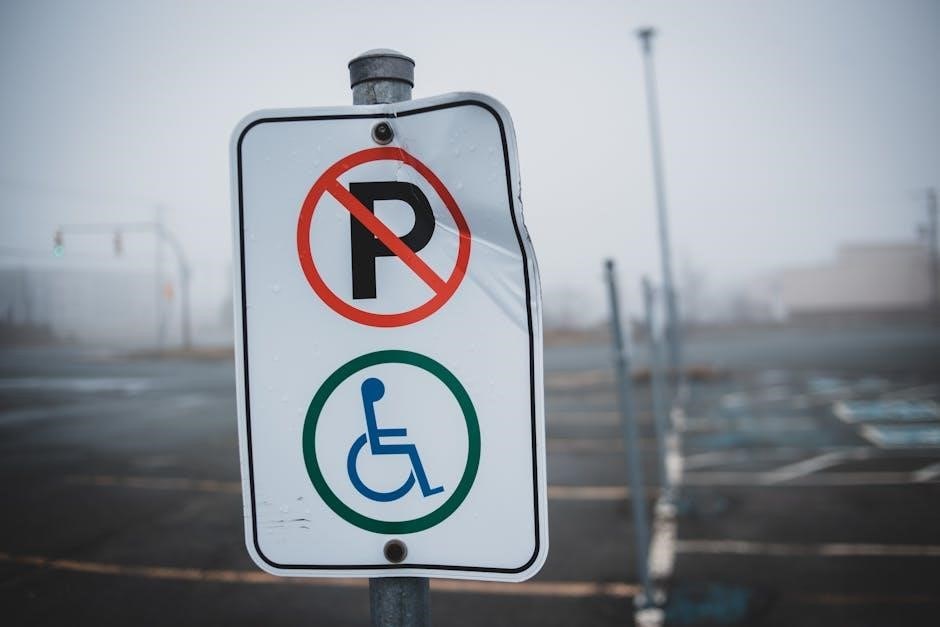The 3-Day Notice to Vacate is a legal document in Ohio eviction law, requiring tenants to address non-payment or lease violations within 72 hours to avoid court action.
What is a 3-Day Notice to Vacate?
A 3-Day Notice to Vacate is a legal document used by landlords in Ohio to initiate the eviction process. It informs tenants of specific issues, such as unpaid rent or lease violations, and requires them to resolve the problem within 72 hours. This notice is formal and must include the tenant’s name, property address, and a clear statement of the issue. It also outlines the actions the tenant must take to avoid eviction, such as paying overdue rent or correcting lease violations. If the tenant fails to comply, the landlord can proceed with filing an eviction complaint. This notice is a critical step in Ohio eviction law, ensuring landlords follow legal procedures before taking further action.
Importance of the Notice in Ohio Eviction Law
The 3-Day Notice to Vacate is a critical legal requirement in Ohio eviction law, serving as the first formal step to address tenant non-compliance. It provides tenants with a clear opportunity to resolve issues, such as unpaid rent or lease violations, within a specified timeframe. This notice is essential for landlords to avoid unlawful eviction claims, as it demonstrates compliance with legal procedures. If tenants fail to respond, the notice becomes the foundation for filing an eviction complaint. Its importance lies in balancing tenant rights with landlord remedies, ensuring the eviction process is fair and lawful. Properly serving this notice is vital to prevent delays and potential legal challenges down the line.

When to Use a 3-Day Notice to Vacate
The 3-Day Notice to Vacate is used for non-payment of rent, lease violations, or illegal activities, providing tenants a chance to resolve issues before eviction proceedings begin.
Non-Payment of Rent
Non-payment of rent is a primary reason for issuing a 3-Day Notice to Vacate in Ohio. When tenants fail to pay rent, landlords can serve this notice, demanding payment within three days. The notice must specify the overdue amount and the deadline for payment. If tenants pay the full amount by the deadline, the eviction process halts. However, if they fail to pay, landlords can proceed with filing an eviction complaint. This legal step ensures landlords can address unpaid rent promptly while providing tenants a final opportunity to resolve the issue. Proper documentation and adherence to Ohio eviction laws are crucial in this process.
Violation of Lease Agreement
A 3-Day Notice to Vacate can also be issued if a tenant violates the terms of the lease agreement. This includes breaches such as unauthorized occupants, pets, or subletting without permission. The notice must specify the violation and demand corrective action within three days. If the tenant fails to remedy the issue, the landlord can proceed with eviction. Common violations include noise disturbances, illegal activities, or failure to maintain the property. The notice must clearly outline the breach and the required resolution. Tenants who do not comply risk eviction proceedings. This step ensures landlords can enforce lease terms while providing tenants an opportunity to address the issue promptly. Proper documentation is essential to support the eviction process if needed.
Illegal Activities on the Premises
Illegal activities on the premises are a serious ground for issuing a 3-Day Notice to Vacate in Ohio. This includes drug manufacturing, illegal gambling, or other unlawful acts conducted on the property. The notice must explicitly state the illegal activity and demand its immediate cessation. Tenants are not provided an opportunity to cure such violations, as these actions are considered a direct threat to the property and public safety. Landlords must ensure the notice clearly outlines the illegal activity and the requirement to vacate within three days. Failure to comply allows the landlord to proceed with eviction. Proper documentation of the illegal activity is crucial for legal proceedings. This provision ensures landlords can act swiftly to protect their property and comply with legal standards.
How to Serve the 3-Day Notice
The notice must be delivered by leaving it at the tenant’s residence or leased premises and sending a copy by regular and certified mail for proof of service.
Methods of Service
The 3-Day Notice to Vacate in Ohio must be served properly to ensure legal validity. Landlords can deliver the notice by handing it directly to the tenant or leaving it at the leased premises. If personal delivery isn’t possible, the notice can be posted on the main entry door of the tenant’s residence. Additionally, sending the notice via regular mail and certified mail is recommended to provide proof of service. Proper documentation, such as a certified mail receipt or an affidavit of service, is essential to confirm delivery. Landlords must adhere to Ohio Revised Code Section 1923.04, which outlines the legal requirements for serving eviction notices. Ensuring the tenant receives the notice within the specified timeframe is crucial for proceeding with the eviction process.
Proof of Service Requirements

Proof of service is essential to validate the delivery of the 3-Day Notice to Vacate in Ohio. Landlords must document how and when the notice was served. Acceptable methods include obtaining a certified mail receipt, having a witness sign an affidavit, or using a process server. The proof of service must detail the date, time, and method of delivery. Without proper documentation, the eviction case may be dismissed. It is crucial to retain all records, as courts require evidence that the tenant received the notice. Failure to provide adequate proof of service can delay or invalidate the eviction process, emphasizing the importance of adhering to Ohio’s legal requirements for serving eviction notices.

What the Notice Must Include
The 3-Day Notice to Vacate must include the tenant’s name, address, a clear statement of the cause, and a deadline for compliance or vacating the premises.
Required Information
The 3-Day Notice to Vacate must include the tenant’s full name, address of the rental property, and a clear statement of the reason for the notice, such as non-payment of rent or lease violation. It should also specify the exact amount of past-due rent, if applicable, and provide a deadline for the tenant to comply or vacate. The notice must reference Ohio Revised Code 1923.04 and include a description of the premises to ensure clarity. Additionally, it should state that failure to respond within three days may result in legal eviction proceedings. The language must be straightforward and avoid ambiguity to ensure legal validity. Properly including all required details ensures the notice is enforceable under Ohio law.
Deadline for Tenant Response
The 3-Day Notice to Vacate requires tenants to respond within 72 hours, excluding weekends and legal holidays, unless the third day falls on one. The deadline begins when the notice is served, not when it is received. Tenants must either pay past-due rent, cure lease violations, or vacate the premises by the specified date. If the tenant fails to comply, the landlord may proceed with filing an eviction complaint. The deadline is strictly enforced under Ohio law, and tenants are encouraged to act promptly to avoid legal consequences. Properly serving the notice ensures the timeline is clear and binding for both parties. Missing the deadline can lead to further legal action, emphasizing the importance of timely response.
Tenant’s Response to the Notice
Tenants must respond within three days by paying rent, curing violations, or vacating. Failure to respond may lead to legal eviction proceedings against them.
Paying Past-Due Rent
Paying past-due rent is a common response to a 3-Day Notice to Vacate in Ohio. Tenants must pay the specified amount within three days to avoid eviction. This option is available if the notice was served due to non-payment of rent. The payment must be made in full, and tenants should obtain a receipt as proof. If the tenant pays, the eviction process is halted, and the tenant may continue living in the property. However, this does not forgive future rent payments, and tenants must remain current to avoid further legal action. If the tenant fails to pay, the landlord can proceed with filing an eviction complaint. This step is crucial for tenants to avoid losing possession of the property.
Curing Lease Violations
Tenants in Ohio who receive a 3-Day Notice to Vacate for lease violations may cure the issue within the specified timeframe. This involves addressing the violation, such as resolving noise disturbances, removing unauthorized occupants, or fixing damages. Once the violation is cured, the landlord must cease eviction proceedings. However, if the violation is severe or recurring, the landlord may still pursue eviction. Tenants should act promptly to correct the issue and provide proof of compliance to avoid further legal action. This option demonstrates the tenant’s willingness to resolve disputes amicably and maintain the tenancy. It is essential for tenants to understand their responsibilities and take immediate steps to remedy any breaches of the lease agreement.
Vacating the Premises

If a tenant chooses to vacate the premises in response to a 3-Day Notice to Vacate in Ohio, they must do so within the specified timeframe. This means removing all personal belongings and returning the keys to the landlord. Tenants are expected to leave the property in good condition, reasonable wear and tear excepted. Failure to vacate within the three-day period may result in the landlord filing an eviction complaint. Once the eviction process begins, tenants may face court proceedings and potential removal by law enforcement. It is crucial for tenants to take the notice seriously and either comply by vacating or address the issue through other means, such as curing lease violations or paying overdue rent. Compliance ensures avoidance of further legal consequences and protects the tenant’s rights.
The Eviction Process After the Notice
If tenants do not comply with the 3-Day Notice, landlords may file an eviction complaint, leading to court proceedings and potential judgment execution to regain possession.
Filing an Eviction Complaint
Filing an eviction complaint in Ohio is the next step if tenants fail to respond to the 3-Day Notice. Landlords must prepare and submit a formal complaint to the appropriate court, typically in the county where the rental property is located. The complaint must include details such as the tenant’s non-compliance, the 3-Day Notice served, and the landlord’s intent to regain possession. Proper documentation, including the lease agreement and proof of notice service, is essential. The court will review the case, and if the landlord prevails, a summons will be issued to the tenant. This step marks the official start of legal proceedings to resolve the eviction dispute.
Court Proceedings
Court proceedings in Ohio eviction cases begin after the landlord files a complaint and the tenant is served a summons. Tenants typically have a short period (e.g., 7-14 days) to respond formally. A hearing is scheduled where both parties present evidence. Landlords must prove the tenant violated the lease or failed to pay rent despite the 3-Day Notice. Tenants may argue extenuating circumstances or defenses. If the court rules in favor of the landlord, a judgment for possession is granted, allowing the landlord to proceed with eviction. If the tenant prevails, the case is dismissed. Court proceedings ensure both parties have an opportunity to be heard, maintaining legal fairness and transparency in the eviction process.
Execution of Judgment
Execution of judgment occurs after the court rules in favor of the landlord, granting a writ of restitution. This writ authorizes law enforcement to remove the tenant and their belongings from the property. Typically, the tenant is given a final 7-14 days to vacate voluntarily after the judgment. If they fail to comply, the sheriff or constable will enforce the eviction, ensuring the landlord regains possession. The tenant’s belongings may be stored temporarily, and they may be liable for storage costs. Landlords must follow legal procedures to avoid liability for improper eviction. This final step ensures the eviction process is legally executed, protecting both parties’ rights and maintaining the rule of law in Ohio eviction cases.

Landlord’s Responsibilities
Landlords must provide proper documentation, avoid self-help evictions, and ensure legal compliance throughout the eviction process to protect their rights and maintain tenant-landlord legal standards in Ohio.
Avoiding Self-Help Evictions
Landlords in Ohio must avoid unlawful self-help eviction methods, such as changing locks or removing tenant property without a court order. Engaging in such practices is illegal and can result in legal consequences, including fines and liability for damages. Proper eviction procedures must be followed, starting with the 3-Day Notice to Vacate and continuing through the court system. Landlords are required to obtain a court judgment before taking possession of the property. Failure to comply with legal standards can lead to penalties and undermine the landlord’s case. Adhering to Ohio eviction laws ensures a lawful and fair process for both parties involved.
Providing Proper Documentation
Providing proper documentation is crucial for landlords in Ohio to ensure compliance with eviction laws. The 3-Day Notice to Vacate must include accurate details, such as the tenant’s name, address, and specific reasons for the eviction. Landlords must maintain records of all communications, including proof of service for the notice. This documentation should clearly outline the tenant’s obligations, such as unpaid rent or lease violations, and the deadline for resolution. Failure to provide accurate and complete documentation can lead to legal challenges and delays in the eviction process. Proper record-keeping also helps landlords demonstrate adherence to legal standards, protecting their rights in court. Ensuring all paperwork is correctly prepared and served is essential for a smooth eviction proceeding.

Tenant’s Rights and Options
Tenant’s rights include responding to the 3-Day Notice by paying rent, vacating, or seeking legal advice. They are protected from unlawful eviction practices.
Understanding Tenant Rights
Tenants in Ohio have specific rights when served with a 3-Day Notice to Vacate. They are entitled to a 72-hour window to respond, either by paying overdue rent, curing lease violations, or vacating the premises. Tenants are protected from unlawful eviction practices, and landlords must follow legal procedures. If tenants believe the notice is unfair or incorrect, they can seek legal advice or challenge the eviction in court. Understanding these rights is crucial for tenants to avoid unnecessary legal consequences and ensure their interests are protected throughout the eviction process.
Seeking Legal Assistance
Tenants facing a 3-Day Notice to Vacate in Ohio should consider seeking legal assistance to understand their rights and options. An attorney can review the notice for compliance with state law and help tenants challenge unfair or improper eviction attempts. Legal aid organizations or tenant rights groups can provide free or low-cost advice, ensuring tenants are informed about their legal protections. If tenants believe the notice was issued unlawfully or without proper cause, legal representation can help them navigate the court process and potentially prevent eviction. Acting quickly is crucial, as the 3-day window limits the time available to respond effectively. Seeking legal help can make a significant difference in protecting tenants’ interests and ensuring fair treatment under Ohio eviction laws.

Sample 3-Day Notice to Vacate Template
A sample template provides a structured format for landlords to issue a proper 3-Day Notice, ensuring compliance with Ohio eviction laws and including all required details.
Sample Template Overview
A sample 3-Day Notice to Vacate template provides landlords with a structured format to issue a legally compliant eviction notice in Ohio. It typically includes sections for tenant and property details, a clear statement of the violation (e.g., non-payment of rent or lease breach), and a deadline for compliance. The template ensures landlords meet Ohio’s legal requirements, such as specifying the exact amount of overdue rent or describing the lease violation. It also outlines the consequences of non-compliance, such as proceeding with eviction. Many templates are available online or through legal aid resources, offering a customizable and professional way to initiate the eviction process while adhering to state laws.
Where to Find Official Forms

Official 3-Day Notice to Vacate forms for Ohio can be obtained from reliable sources to ensure compliance with state eviction laws. Landlords can access these forms through the Ohio Secretary of State’s website or local county clerk’s office. Additionally, legal aid organizations and real estate associations often provide downloadable templates. Websites like formspal.com and bit.ly/3CHLXHl offer free or low-cost Ohio-specific eviction notices. It’s crucial to use official or attorney-approved templates to avoid legal issues. These forms are designed to meet Ohio’s legal requirements, ensuring landlords follow proper procedures when initiating eviction proceedings. Using the correct form helps prevent delays and potential dismissal of the case in court.
Conclusion
The 3-Day Notice to Vacate is a crucial step in Ohio evictions, ensuring legal compliance and balancing landlord and tenant rights. Landlords must follow proper procedures and seek legal advice to avoid issues.
Final Thoughts on the 3-Day Notice
The 3-Day Notice to Vacate is a critical legal tool in Ohio, balancing landlord and tenant rights. It provides tenants a final opportunity to resolve issues like unpaid rent or lease violations within 72 hours. Properly serving the notice and adhering to state laws is essential to avoid legal complications. Landlords must avoid self-help evictions and ensure compliance with Ohio Revised Code Section 1923.04. Tenants should understand their rights and seek legal advice if needed. This notice is not just a formal step but a chance for resolution before escalating to court. Its effectiveness lies in clear communication and adherence to legal standards, ensuring fairness for all parties involved.

Importance of Compliance
Compliance with Ohio’s 3-Day Notice to Vacate requirements is crucial for landlords to ensure the eviction process remains legally valid. Properly serving the notice and adhering to state laws prevents delays and potential dismissal of eviction cases. Landlords must avoid self-help eviction methods, such as changing locks or removing belongings, as these actions violate tenant rights and can lead to legal consequences. Ensuring the notice includes all required information and is served correctly maintains the integrity of the process. Compliance also protects landlords from liability, demonstrating their commitment to fair and lawful eviction practices. Tenants, too, benefit from clear guidelines, allowing them to understand their obligations and respond appropriately within the specified timeframe.
